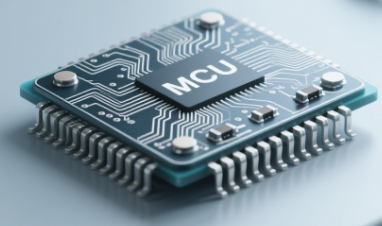A Microcontroller Unit (MCU) is a compact, self-contained computer on a single integrated circuit (IC), designed to execute specific tasks in embedded systems. Unlike general-purpose microprocessors (MPUs) in computers or smartphones, MCUs integrate a central processing unit (CPU), memory (RAM, ROM, flash), input/output (I/O) peripherals, and timing circuits into one chip, making them cost-effective, low-power, and ideal for dedicated applications.
An MCU’s architecture combines critical elements to enable independent operation:
-
Central Processing Unit (CPU): The "brain" that executes instructions from memory, handling arithmetic, logic, and control operations. MCUs often use reduced instruction set computing (RISC) architectures (e.g., ARM Cortex-M, PIC) for efficiency.
-
Memory Modules:
-
Flash Memory: Stores program code and permanent data, retainable without power.
-
RAM: Temporary data storage for active tasks, enabling fast access during operation.
-
EEPROM: Non-volatile memory for small, frequently updated data (e.g., user settings).
-
Peripherals: Built-in hardware components that extend functionality:
-
Digital I/O Pins: Interface with sensors, LEDs, buttons, or motors, sending/receiving binary signals.
-
Analog-to-Digital Converters (ADCs): Convert analog signals (e.g., from temperature sensors) to digital data for CPU processing.
-
Timers/Counters: Manage time-sensitive tasks like pulse-width modulation (PWM) for motor speed control or periodic data sampling.
-
Communication Interfaces: UART, SPI, I2C, CAN, or Bluetooth modules for data exchange with other devices.
-
PWM Controllers: Generate variable voltage signals to control devices like servos or LED brightness.
-
Clock & Power Management: Oscillators (internal or external) provide timing signals, while power management units (PMUs) optimize energy use, critical for battery-powered devices.
MCUs are categorized by architecture, performance, and application:
-
8-bit MCUs: Low-cost, simple devices (e.g., Microchip PIC16) used in basic applications like remote controls or toys, with limited processing power.
-
16-bit MCUs: Balance performance and efficiency (e.g., TI MSP430), suitable for sensors or industrial controls requiring moderate data handling.
-
32-bit MCUs: High-performance options (e.g., STM32, NXP Kinetis) with RISC cores, supporting complex tasks like IoT connectivity, motor control, or embedded AI.
-
64-bit MCUs: Emerging for advanced applications (e.g., automotive ADAS), offering enhanced processing for machine learning and high-speed data.
-
Specialized MCUs:
-
Automotive-Grade: AEC-Q100 qualified, designed to withstand extreme temperatures and vibrations (e.g., in engine control units).
-
Low-Power MCUs: Optimized for battery life in wearables or remote sensors (e.g., Nordic nRF52 series).
-
Industrial MCUs: Ruggedized for factory automation, with extended temperature ranges and noise immunity.
MCUs are the backbone of countless embedded systems, enabling smart functionality in:
-
Consumer Electronics: Smartphones (camera control), wearables (fitness tracking), home appliances (washing machine cycles), and toys (remote operation).
-
Automotive: Engine control units (ECUs), anti-lock braking systems (ABS), infotainment, and ADAS (collision detection sensors).
-
Industrial Automation: Robotics (motor control), sensors (temperature/pressure monitoring), and programmable logic controllers (PLCs).
-
Healthcare: Medical devices like pacemakers (timed pulses), glucose monitors (data processing), and portable diagnostic tools.
-
IoT & Smart Devices: Smart thermostats, security cameras, and connected home systems, enabling remote monitoring and control.
-
Aerospace & Defense: Avionics systems (navigation), drones (flight stabilization), and military sensors (environmental monitoring).
-
Cost-Effective: Integration of components reduces the need for external hardware, lowering overall system costs.
-
Compact Size: Small form factors suit space-constrained applications (e.g., wearables, medical implants).
-
Low Power Consumption: Optimized for battery operation, extending life in portable devices.
-
Ease of Programming: Supported by development tools (e.g., Arduino, MPLAB) and languages (C, Python), enabling rapid prototyping.
-
Reliability: Designed for specific tasks, ensuring consistent performance in harsh environments.
-
AI & Machine Learning: MCUs with integrated neural processing units (NPUs) enable edge AI, allowing devices to process data locally (e.g., voice recognition in smart speakers).
-
Connectivity: Enhanced support for 5G, Wi-Fi 6, and Bluetooth Low Energy (BLE) to enable seamless IoT integration.
-
Energy Efficiency: Advances in process technology (e.g., 28nm, 16nm) reduce power consumption, critical for sustainability.
-
Security: Built-in encryption (e.g., AES) and secure boot features protect against cyber threats in connected devices.
Keywords: Microcontroller Unit, MCU, embedded systems, 8-bit MCU, 32-bit MCU, RISC architecture, IoT microcontrollers, low-power MCU, automotive MCU.
MCUs continue to evolve, driving innovation in smart technology by bridging the gap between hardware and software in embedded applications.
